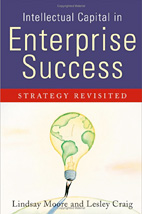Not every company is in a position to practice classical carrot and stick style licensing. But that does not mean that licensing is not an option for every business, regardless of the intangible assets they own.
Archives for September 2011
Surviving Financial Crisis with Structural Capital (PDF)
With an intellectual-asset audit, companies can often find Rembrandts in the attic. Ideas, patents, trademarks and/or infringements are often discovered that may help capitalize the enterprise that holds them.
Towards a Strategy of Valuing Patents as Intellectual Capital
Patents are a major force in the world economy, and one of only a few metrics commonly employed to gauge the tides of new ideas and innovation that are driving our economy. Even with the present declining rates of R&D investment, leading nations spend over $1 billion dollars each day generating intellectual property.
How Do We Think Strategically?
Within today’s rapidly changing corporations, individuals at all levels are increasingly called upon to demonstrate their ability to think strategically. However, many are inadequately prepared to perform this task. Many new executives, and even those long within the executive ranks, are unsure how to properly engage in strategic thinking.
Intangible assets, intellectual capital or property? It does make a difference
In modern discussions regarding the value of intellectual property, terminology can often become confusing. To prevent misunderstanding, it’s important to differentiate between “intangible assets,” “intellectual capital” and “intellectual property.”
Making Marketing Strategic
Marketing, as a functional discipline, has had to reinvent itself more than once during the last decade. Remember the distinction in the 1980s between “sales oriented” and “marketing oriented” companies? The first big change was during the early 1990s when marketing was routed from it pedestal in “marketing oriented” companies to become the handmaiden of branding…
Branding Diamonds
During the 1990s, De Beers Consolidated Mines began the then seemingly unusual practice of “Branding” its diamonds. It began inscribing a small Brand Mark on its stones to differentiate its products within the commodity marketplace, and to ensure their worth against the inexorable declining value of non-oil commodities. The growing success of Brands, Branding and the strategies of Consumer Packaged Goods (CPG) Marketing are widely recognized within the global business community.


 As the knowledge-based economy expands, the companies and individuals that possess intangible intellectual assets, such as intellectual property, will need specialized expertise, strategic thinking, legal experience, and the wisdom necessary to manage intellectual assets.
As the knowledge-based economy expands, the companies and individuals that possess intangible intellectual assets, such as intellectual property, will need specialized expertise, strategic thinking, legal experience, and the wisdom necessary to manage intellectual assets.